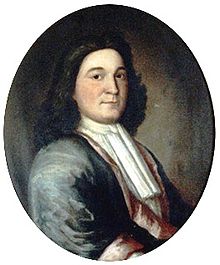Massachusetts Charter
| The charter granted by Their Majeſties King William and Queen Mary to the inhabitants of the province of the Maſſachuſetts-Bay, in New England | |
|---|---|
Land Grant | |
| Context | British colonization of the Americas Glorious Revolution Dissolution of the Dominion of New England |
| Signed | October 7, 1691 |
| Location | Westminster |
| Expiration | October 25, 1780 |
| Signatories | Sir George Hutchins Sir William Rawlinson Sir John Trevor |
| Language | English |
The Massachusetts Charter of 1691 was a
The charter was approved by William and Mary on October 7, 1691, and established English rule of the colony by appointing a governor, deputy governor, and secretary, to be elected by members of the council.
Towns across the colony grew in status as a result of the charter.[why?][7]
History
With the

A draft of the charter was drawn up by the
Effects
Other than an increase in land under control of the
With the passage of what came to be known as the Intolerable Acts by the Parliament of England, many colonists became dissatisfied with the governmental arrangement. The political tension culminated in the Boston Tea Party, which resulted in the cancellation and dissolution of the General Court by Thomas Gage. The members of the General Court cited the 1691 Charter as their constitutional authority and did not recognize the actions of Gage as legitimate. The delegates then met and formed the Massachusetts Provincial Congress in 1774. The Provincial Congress became the revolutionary government of the Province of Massachusetts Bay, with the 1691 charter acting as the de facto constitution of Massachusetts Bay until the formulation and passage of the Constitution of Massachusetts in 1780.[12][13][14][15]
See also
- Charter of the Massachusetts Bay Company
- Mayflower Compact
- Massachusetts Body of Liberties
- Constitution of Massachusetts
References
- ISBN 978-1-55553-304-5. Retrieved 20 July 2012.
- ^ "Massachusetts Government Act". Historywiz.com. Retrieved 20 July 2012.
- ^ ISBN 978-0-495-90921-7. Retrieved 20 July 2012.
- ^ "The Charter of Massachusetts Bay - 1691". 18 December 1998.
and for the greater Ease and Encouragement of Our Loveing Subjects Inhabiting our said Province or Territory of the Massachusetts Bay and of such as shall come to Inhabit there Wee doe by these presents for vs Our heires and Successors Grant Establish and Ordaine that for ever hereafter there shall be a liberty of Conscience allowed in the Worshipp of God to all Christians (Except Papists) Inhabiting or which shall Inhabit or be Resident within our said Province or Territory
- ISBN 978-1-60647-541-6. Retrieved 20 July 2012.
- ^ United States Congress (1913). Congressional Edition. U.S. G.P.O. p. 2405. Retrieved 20 July 2012.
- ISBN 978-0-313-33155-8. Retrieved 20 July 2012.
- ^ Hutchinson 1765, p.350.
- ^ Hutchinson 1765, p.355.
- ^ Hutchinson 1765, p.361.
- ^ Hutchinson 1765, p.365.
- ^ a b Morison 1917, p.9.
- ^ Morison 1917, p.10.
- ^ Morison 1917, p.12.
- ^ Morison 1917, p.11.
- Hutchinson, Thomas (1765). The History of the Colony of Massachusetts-Bay, From the Settlement thereof in 1628 until its Incorporation.
- Morison, Samuel (1917). A History of the Constitution of Massachusetts. Harvard University Library: Wright & Potter Printing Co.
